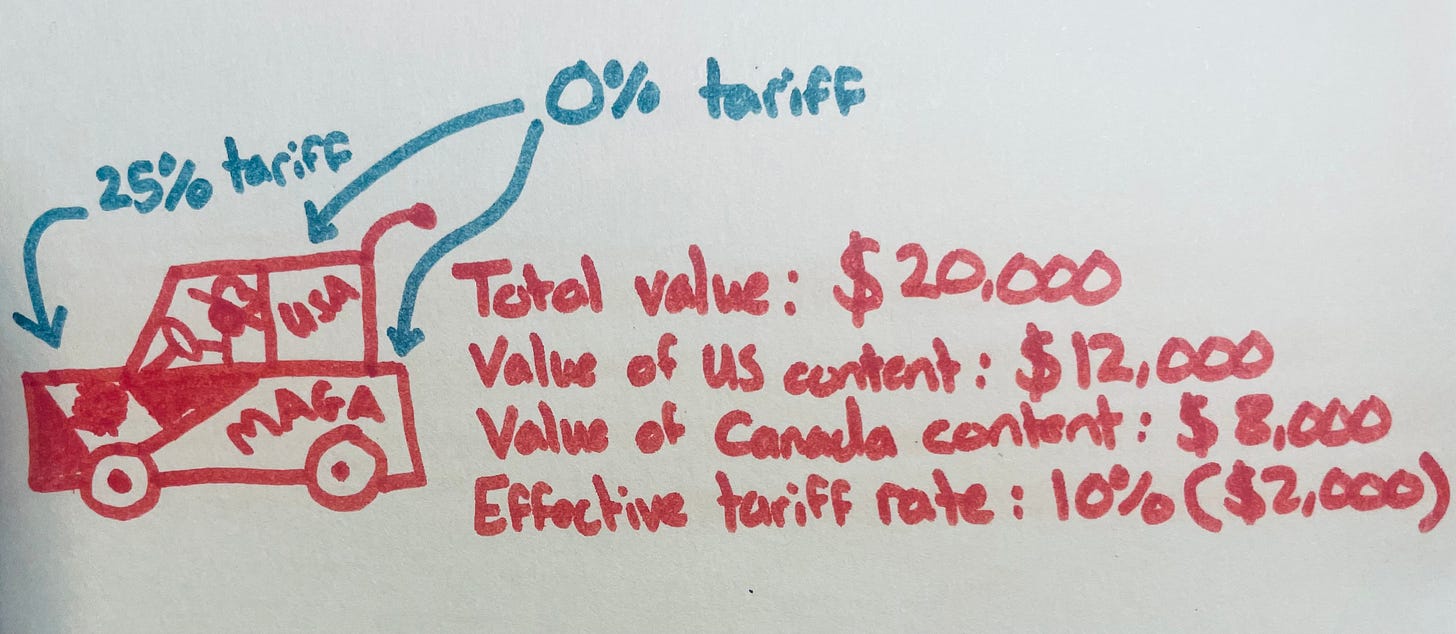Earlier this week, Donald Trump signed an Executive Order (EO) implementing the UK-US deal.
While the EO isn’t exclusively about creating a new US tariff-rate quota, allowing 100,000 UK car exports to qualify for a 10 per cent tariff1 each year — it also clarifies that aerospace products will trade tariff-free and sets out a process for creating a new tariff-rate quota for UK steel and aluminium exports — it is … mainly about cars.
And this tariff-rate quota is relatively good news for the UK, subject to some additional necessary clarifications about, for example, the rules of origin that the US will apply.
To recap, there are now two arrangements/deals providing a degree of relief from Trump’s 25 per cent tariff on autos:
Canada and Mexico. So long as they qualify for USMCA, cars exported to the US from Canada and Mexico benefit from lower tariff rates. This is because the 25 per cent tariff only applies to the non-US originating value of the car. I explained this process here, but this drawing hopefully gives you a general idea of how this results in a de facto lower tariff:
The UK. As described above.
And I’m starting to wonder whether that might be it.
The Canada/Mexico arrangement isn’t really replicable for anyone else because it is borne of the highly integrated North American supply chains.
But the UK’s car/trade relationship with the US is also pretty unique. For one, the UK doesn’t export many vehicles in the grand scheme of things. And the vehicles it does export to the US tend to be at the luxury end of the market.
So if you’re Donald Trump and you’re looking to use tariffs to forcibly onshore car production, giving the UK a bit of a break doesn’t really undermine your plans. And if you’re the UK, a 100,000 unit quota tariffed at 10 per cent is pretty good given pre-Trump trade volumes (around 101,000 units in 2024) and products that are presumably slightly less price sensitive (so able to absorb the 10 per cent tariff, if not the 25 per cent).
Is this true of other major exporters to the US? I’m not so sure.
For example, in 2024 the EU exported around 789,000 vehicles to the US. A 100,000 unit quota would only capture around 13 per cent of total exports. For South Korea and Japan, the numbers are event bigger — at around 1.2 and 1.3 million units respectively. Here a 100,000 unit quota would only capture around 8 and 7 per cent of the 2024 trade flows.
Is Trump going to agree to a quota for the EU, South Korea, and Japan that covers anywhere close to the same proportion of 2024 trade as he did for the UK (99 per cent)? I kinda doubt it.
Would any of these markets even accept a 100,000 unit per year TRQ? I also doubt it.
In addition, the average value per unit of export for all three markets is lower or significantly lower than the UK’s. The UK’s average value per unit of exports is around 75,000 USD. The EU’s is around 54,000 USD, while South Korea and Japan are both around 29,000 USD.
So is an in-quota 10 per cent tariff even good enough? If I had to guess, they would all eventually take it if applied to sufficent volume because 10 is still lower than 25, but a 10 per cent tariff would continue to have a significant negative impact on South Korean and Japanese exports to the US in particular.
All of this in table form:
Table 1: Vehicle exports to the US
But yeah. Not super confident we’re going to see more deals on cars. And if there are, and we assume a 10 per cent tariff is the floor, I expect higher volumes to be accompanied by a higher in-quota tariff rate.
Other stuff
The European Commission has used its new International Procurement Instrument (IPI) to exclude Chinese companies from EU purchases of medical devices valued at over EUR 5 million and, interestingly, will allow no more than 50 per cent of inputs from China for successful bids. Read more here.
US and EU efforts to engage in reverse technology transfer, wherby they try to forced Chinese firms in key sectors to invest locally and then learn their tricks, are being thrwarted by China not letting its firms in sectors such as auto and AI invest and build stuff in other countries. Read more here.
Best,
Sam
Note: instead of a 27.5 per cent tariff [Pre-existing MFN tariff of 2.5 per cent plus trade war tariff of 25 per cent]






